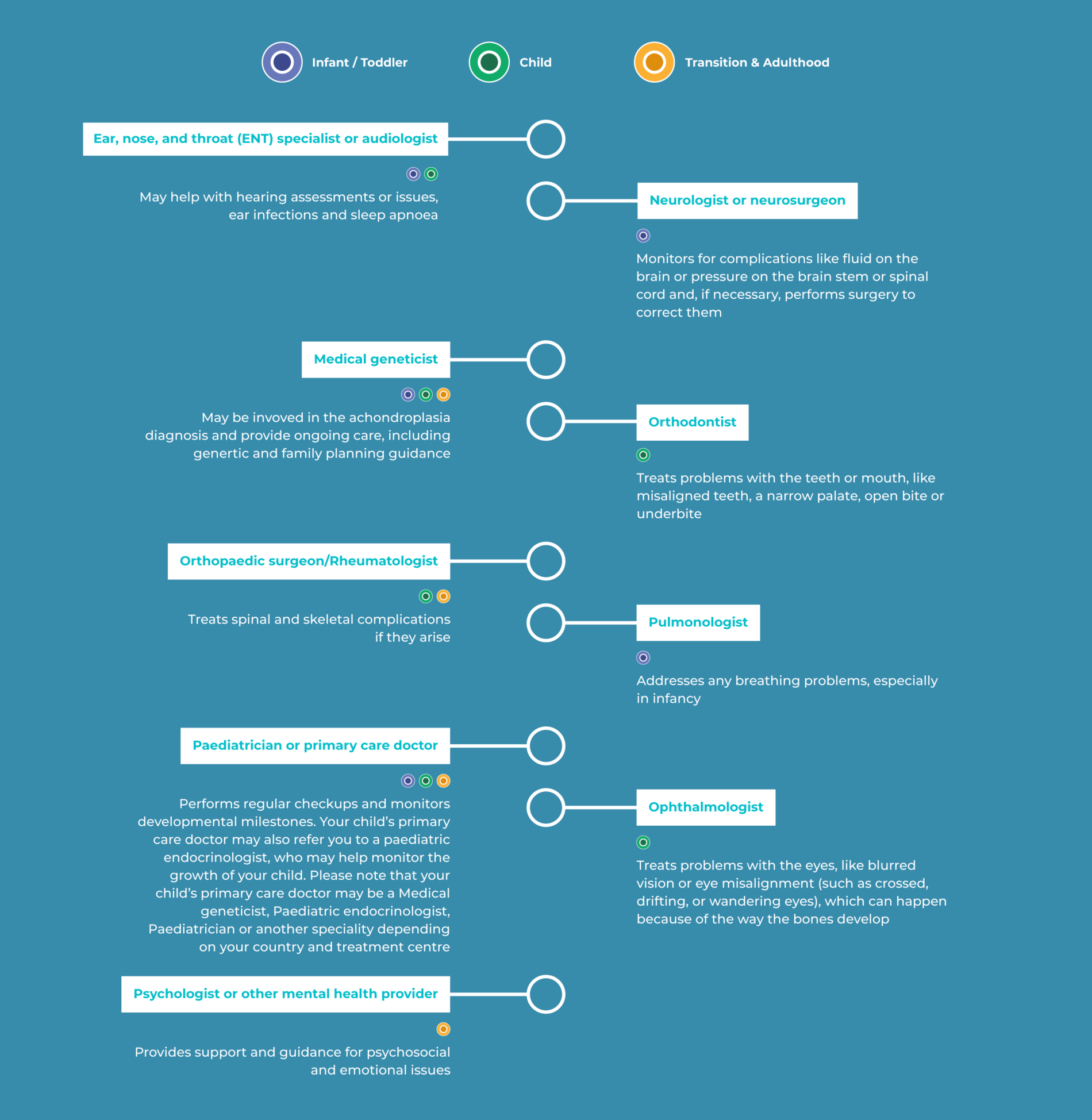Because of the effects throughout the body, many specialists may play a role in caring for people with achondroplasia. Different specialists may become involved at certain times throughout life. Some will be part of the care team throughout life, while others will be more important at certain ages. Talk with your doctor to learn more about the medical professionals who may be involved.
Each person’s healthcare team may differ. These are some of the specialists that may be seen over time.

It is important to work with a surgeon and anesthesiologist who have experience treating people with achondroplasia. This is because of the special considerations needed to reduce the risks of complications associated with airway management and other anatomical differences.
Expert medical care is just one part of caring for a child with achondroplasia. There are also practical considerations, from keeping your infant safe to accommodating the physical needs of your school-age child. Taking proactive steps and turning to others for support can help. You can share this information with your child’s pediatrician, who may be less familiar with achondroplasia than the specialists your child sees.
The early months of your baby’s life require extra attention. This is because of potentially serious complications that can happen in that first year. You can help protect your infant by following your doctor’s advice and some basic guidelines. Many of these are common-sense tips for the safety of all babies:
Be sure to always support your baby’s head, neck, and full spine.
Give your baby lots of supervised tummy time.
When shopping for a stroller, choose one with a solid back.
Keep your child in a rear-facing car seat as long as possible.
Don’t let your baby sit unsupported until they can do so on their own. That independence will come in time.
Be careful about the type of automatic swing you choose. Select one with a hard surface and keep it inclined at a 45-degree angle.
Ask your skeletal dysplasia specialist for recommendations for the best types of swings, car seats, and other supportive devices for infants with achondroplasia. Be sure to talk to your doctor for medical advice on how to best protect your infant.


A hallmark of growing up is independence. As children get older, they want to do more on their own—at home, in school, and out in the world. Some simple adaptations to your child’s environment can help them achieve independence and do things for themselves. It’s important to be proactive and reach out to your child’s school about basic adaptations that can help.
Step stools, lower door levels and light switches, and lower appropriate kitchen appliances are just a few examples of everyday basic accommodations that can make life easier for children and adults with achondroplasia.
Personal hygiene is just that—personal. But your child may need help with hygiene, either from another person or by using adaptive tools, such as a toilet wand, which can be introduced when potty training.
In school, adaptations like weighted pens and wrist braces can help your child keep up with note-taking and written assignments. Lower hooks and cubbies can also help your child be independent
Modified chairs provide better back support, and foot stools keep your child’s feet from dangling for more comfort in school and at home.
When your teenager starts to drive, pedal extenders can help them reach the pedals so they can drive safely, and seat boosters can help them see above the dashboard.
The adolescent years are tough. From peer pressure to insecurities, teenagers go through a lot. These years can create unique challenges for a teenager with achondroplasia, who may feel different, left out or bullied. Sadly, social challenges cause some teens with achondroplasia to experience depression or anxiety.
These challenges can carry into adulthood. It’s important to connect with resources that can offer psychological and social support, such as mental health professionals, school counselors and advocacy groups.
Advocacy groups also offer support groups so families can connect with one another.
